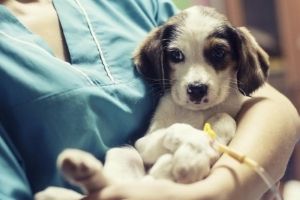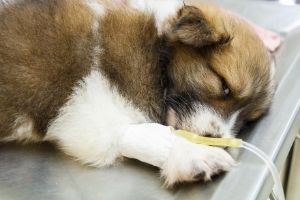If you’ve ever had a puppy, the term “parvo”—short for parvovirus—is surely enough to send shivers down your spine. This extremely contagious virus is known for taking a previously healthy puppy that was showering you with smelly puppy breath kisses and playing one day to nearly or fatally ill in a matter of days. Thankfully, this disease in dogs is preventable and somewhat treatable if caught early, so we’ve taken the time in this article to share all the signs, risks, and ways to prevent this horrifying virus. This should be required reading for breeders and puppy owners alike.
What is Parvo?
Parvovirus is an infectious and potentially deadly gastrointestinal (GI) illness in puppies and young dogs. One of the reasons this is the dread of the veterinary community is due to the virus’s ability to spread through the dog population.
The dangerous part is that the virus starts to shed 4-5 days after exposure, and this is often before the dog has even begun showing signs of being infected. Then the dog continues to shed the virus while the dog is sick and up to 10 days after recovery, making the quarantine of this poor pup essential—not only for their sake but for the sake of other dogs around them.
How is Parvo Transmitted?
Parvovirus is spread through direct contact with a dog that’s been infected or from feces. It’s even possible for a human to inadvertently give it to a dog by stepping in dog feces and unknowingly tracking that inside the home.
This indirect contact transmission is the most disconcerting, as researchers have found that this hardy virus can live in ground soil for up to one year, and it can even survive on skin, clothing, or equipment. It can also survive at room temperature inside your home and is resistant to almost all cleaners except bleach or a 1:30 bleach solution. Because of these findings, you should always check and remove your shoes before entering your home, especially if you’ve got an unvaccinated puppy.
Breeders also need to realize that if they give up on finding homes for their puppies before they are fully vaccinated and drop them off at a local shelter, there is a distinct possibility that parvo exists there. If the shelters were known for quarantining puppies with parvovirus that might be okay, but not all shelters do this. Do the right thing—fully vaccinate these puppies and/or make sure their new owners will do this.

Is Parvo Only Found in Puppies?
Puppies and younger dogs are the ones that we see most with it simply because, if they have any mother-given immunity, that immunity starts to go away around 12 weeks and will be completely gone around 16 weeks of age. Younger puppies are more susceptible to disease because the mother’s immunity will protect them until around 10 weeks of age, but the vaccine series won’t be complete until around 16 - 24 weeks if you follow your veterinarian's protocol.
Can a Dog Survive Parvo at Home? What is the Treatment For Parvovirus?
Parvo typically requires supportive care. The biggest problem is that the infected puppy is losing so much fluid that they become extremely dehydrated. The immune system gets compromised because the bone marrow cannot produce enough white blood cells, so septicemias set in as well as severe dehydration. So with these parvo pups, the most important thing is to just run fluids into them in large quantities to try to keep them hydrated because they're vomiting and can't keep anything down orally. And there's also massive amounts of very watery diarrhea coming out the other end.
Not all survive parvo, but quite a few can if they're well-hydrated and maintained. There are mixed thoughts about whether giving them immune serum is valuable or not, but proper fluid and electrolyte care is vitally important. Your vet will most likely recommend hospitalizing your dog in an isolation ward, where the pup will be monitored for secondary infections.
Depending on the severity of the case, your vet may also prescribe a series of medications, including antibiotics to prevent bacterial infections from entering your dog through the damaged walls of his intestines.
The first days are the most touch and go. Most puppies that survive the first 3-to-4 days will make a complete recovery, which usually takes around one week. Your vet will send you home with a continued plan to aid in recovery at home.

How Can Parvo Be Prevented?
A proper immunization protocol has to be followed in order to prevent parvo. The parvovirus is usually coupled with the distemper virus vaccinations, and the two core vaccines in dogs are both rabies and distemper. So parvovirus is one of the ones that's paired with the distemper virus vaccine. But if they are vaccinated correctly—meaning the manufacturer's recommendations are adhered to—it’s a huge step in the right direction in preventing parvo. Manufacturers will guarantee the vaccine efficacy if given by a veterinarian following the schedule protocols that they provide to the clinics.
Unfortunately, even vaccinated dogs are not 100% protected from the virus. Vaccines for the parvovirus are recommended for all puppies and are typically administered in a three-shot series when the pup is between 6-to-8 weeks old, again at 10-to-12 weeks, and at 14-to-16 weeks. A booster shot is then given 1 year later and every 3 years after that. The timing between the immunizations is critical, and that's because the immune system is being stimulated, so if there's not another threat posed to the immune system within a reasonable amount of time, it just kind of sits back and says, "Well, everything's fine and we don't need to worry about anything."
Because of this strict schedule and the highly contagious nature of parvo, unvaccinated and incompletely vaccinated puppies shouldn’t be exposed to unvaccinated dogs. As heartbreaking as this is, this also means avoiding crowded places like dog parks or doggy daycare. On a more positive note, unvaccinated puppies can socialize with fully-vaccinated at home without much worry. Any reputable puppy training school will require proof of vaccination before enrollment. As veterinarians, we understand your desire to train and socialize your precious pup, but doing it safely is a must when it comes to preventing the potentially fatal parvovirus. And because of the seriousness of parvo, if you miss a vaccination, your veterinarian will almost certainly recommend you start the series over.

What Are the First Signs and Other Symptoms of Parvo in Dogs?
When asked about signs of parvo in dogs, Dr. Cornell stated, "The first signs of canine parvovirus tend to be decreased appetite, fever, and lethargy. These are not common to see in puppies and should present concern for any caretaker. In a short period, diarrhea and vomiting accommodate the initial presenting symptoms. Canine Parvovirus should always be on the differential list for any puppy between 6 weeks and 6 months of age showing signs mentioned above. Especially if they are not completely up to date on vaccinations."
Other common symptoms of parvovirus are as follows:
- Weight loss
- Depression
- Anorexia
- Dehydration
- Weakness
If you suspect that your pup has parvovirus, contact your veterinarian immediately. Every minute counts in the case of parvo.
Why Have the Rates of Parvovirus Risen During the COVID-19 Pandemic?
If you follow veterinary news at all, you’ve likely seen mentions of “parvo” seemingly increase tenfold with the onset of the Coronavirus. While it’s too early for studies just yet, those of us in the veterinary field posit that the reasons for this spike are twofold:
- So many people have adopted pets during this pandemic, as they have more time at home. With that there has been an increase in dog walks and, in turn, dog interactions as, quite frankly, what else is there to do!?
- Many people have been afraid to take their dogs into the vet, resulting in dogs that have maybe begun but not completed their vaccinations.
AAHA senior veterinary officer Heather Loenser urges veterinarians to educate puppy owners on the necessity of completing the distemper-adenovirus-parvovirus (DAP) series. “It wouldn’t be over the top to ramp up marketing campaigns on the importance of vaccinating pups,” she says, noting that this is particularly crucial with all of the recent dog adoptions.
Again, if we can emphasize one thing, it’s that prevention and early treatment of parvovirus is crucial to the survival of your precious puppy. Make sure to stay on your vaccination schedule but, even if you do and your puppy experiences any of those previously mentioned symptoms, contact us immediately.

